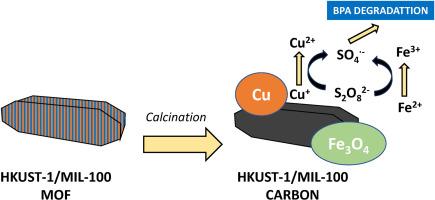通过基于过硫酸盐的高级氧化工艺降解双酚 A 的 MOF 衍生多孔铁-铜@碳催化剂
IF 4.8
3区 材料科学
Q1 CHEMISTRY, APPLIED
引用次数: 0
摘要
以混合 MOF HKUST-1/MIL-100 为前驱体,采用煅烧策略制备了含有铁铜双金属颗粒的多孔复合碳(C-HKUST-1/MIL-100)。通过 XRD、SEM、EDS 光谱和 N2 吸附-解吸对制备的碳进行了表征,证实获得了一种微多孔碳,其结构中均匀分布着铁-铜颗粒。为了进行比较,还分别从相应的 HKUST-1 和 MIL-100 MOFs 中制备了铜碳和铁碳(C-HKUST-1 和 C-MIL-100)。评估了所制备的碳作为异相催化剂对基于过硫酸盐的双酚 A 高级氧化降解的催化性能。铁-铜@碳显示出最佳的催化性能,仅在反应 10 分钟后就能完全降解双酚 A,这与铁和铜的协同作用密切相关。利用铁-铜@碳研究了一些关键参数的影响,包括初始 pH 值、PS 浓度和催化剂用量。此外,所开发的碳具有良好的重复使用性,经过五个循环后,双酚 A 降解效果没有明显下降,并且能够处理实际水样,其优点是由于其磁性,降解后的回收过程变得更加容易。本文章由计算机程序翻译,如有差异,请以英文原文为准。

MOF derived porous Fe-Cu@carbon catalyst for the degradation of bisphenol A through a persulfate-based advanced oxidation process
A calcination strategy based on the use of mixed MOF HKUST-1/MIL-100 as precursor was used for the obtention of a porous carbon composite (C-HKUST-1/MIL-100) containing iron-copper bimetallic particles within it. The prepared carbon was characterized by XRD, SEM, EDS spectroscopy and N2 adsorption-desorption, confirming the obtention of a micro-mesoporous carbon with Fe-Cu particles homogenously distributed within the structure. For comparison, Cu and Fe-carbons (C-HKUST-1 and C-MIL-100, respectively) were also prepared from the corresponding HKUST-1 and MIL-100 MOFs, respectively. The catalytic performance of the developed carbons as heterogeneous catalysts for persulfate-based advanced oxidation degradation of bisphenol A was evaluated. The Fe-Cu@carbon showed the best catalytic performance, leading to a total BPA degradation after just 10 min of reaction, which was closely related to the synergistic effect of iron and copper. The effect of some key parameters including initial pH value, PS concentration and catalyst dosage was investigated using the Fe-Cu@carbon. In addition, the developed carbon showed good reusability, with no apparent loss in BPA degradation, after five cycles and the ability to treat real water samples, with the advantage that the recovery process after degradation is facilitated thanks to its magnetic properties.
求助全文
通过发布文献求助,成功后即可免费获取论文全文。
去求助
来源期刊

Microporous and Mesoporous Materials
化学-材料科学:综合
CiteScore
10.70
自引率
5.80%
发文量
649
审稿时长
26 days
期刊介绍:
Microporous and Mesoporous Materials covers novel and significant aspects of porous solids classified as either microporous (pore size up to 2 nm) or mesoporous (pore size 2 to 50 nm). The porosity should have a specific impact on the material properties or application. Typical examples are zeolites and zeolite-like materials, pillared materials, clathrasils and clathrates, carbon molecular sieves, ordered mesoporous materials, organic/inorganic porous hybrid materials, or porous metal oxides. Both natural and synthetic porous materials are within the scope of the journal.
Topics which are particularly of interest include:
All aspects of natural microporous and mesoporous solids
The synthesis of crystalline or amorphous porous materials
The physico-chemical characterization of microporous and mesoporous solids, especially spectroscopic and microscopic
The modification of microporous and mesoporous solids, for example by ion exchange or solid-state reactions
All topics related to diffusion of mobile species in the pores of microporous and mesoporous materials
Adsorption (and other separation techniques) using microporous or mesoporous adsorbents
Catalysis by microporous and mesoporous materials
Host/guest interactions
Theoretical chemistry and modelling of host/guest interactions
All topics related to the application of microporous and mesoporous materials in industrial catalysis, separation technology, environmental protection, electrochemistry, membranes, sensors, optical devices, etc.
 求助内容:
求助内容: 应助结果提醒方式:
应助结果提醒方式:


